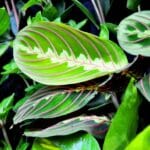There is an evident revival of passion for plants and gardening today because of people’s desire to reconnect with nature. However, modern gardeners work in concrete jungles and live in the confines of tiny homes so they are opting for plants that can keep up with their rather busy work schedule and will thrive in their limited living spaces.
- What Are Succulents?
- Common Types of Succulents
- Agave
- Aloe
- Aster
- Cactus
- 15. Parodia magnifica, Balloon Cactus
- 16. Ferocactus pilosus, Mexican Lime Cactus
- 17. Echinocactus grusonii, Golden Barrel Cactus
- 18. Echinopsis aurea, Golden Easter Lily Cactus
- 19. Schlumbergera buckleyi, True Christmas Cactus
- 20. Gymnocalycium stellatum
- 21. Mammillaria plumosa, Feather Cactus
- 22. Mammillaria elongata, Lady Finger Cactus
- 23. Epiphyllum hookeri, Hooker’s Orchid Cactus
- 24. Acanthocereus tetragonus, Fairy Castle Cactus
- 25. Stenocactus multicostatus, Brain Cactus
- 26. Rhipsalis baccifera, Mistletoe Cactus
- Dogbane
- Echeveria
- Euphorbia
- Geophyte
- Mesem
- Orchid
- Stonecrop
- Yucca
- Caring for Succulents
- Common FAQs
They have found that among the most convenient and reliable plants to grow in this kind of setting are succulents. Succulents are some of the prettiest and easiest plants to grow. They have unique and appealing forms and geometry, they are drought-tolerant, and they can be propagated using simple techniques.
Many of them do not require a lot of space so they will fit well in small pots by the window or in narrow planter boxes outdoors. There is a lot to love about succulents and it is not surprising if you have developed an interest in them.

The wide variety of succulents from small to big, rosette to sprawling, colorful to monochromatic, etc. may sound intimidating but this just gives you a lot more reasons to choose succulents as your next addition to your collection.
If you are a millennial who has just decided to purchase your very first succulent but do not know which one to choose yet or just an enthusiast who wants to get to know succulents more, this simple but comprehensive guide is perfect for you!

What Are Succulents?
In horticulture, what probably comes to mind when talking about succulents are the striking small rose-like plants made of thick fleshy green leaves often found in small pots decorating tabletops. This may be attributed to the general appearance of many succulent plants like echeverias and sedums. However, there are many others in a plethora of sizes and shapes (1).
Any plant that has juicy leaves, stems, and roots are called succulents, hence the term may refer to many plants from different families. These fleshy parts are water-storing tissues resulting from the plant’s adaptation to dry environments (2). Many succulents like cacti are found thriving in deserts and arid regions.
The list of succulent plants is so diverse, at least one species exists in over 25 plant families. Some of these groups that are more commonly grown for ornamental use are agave, aloe, aster, cactus, dogbane, echeveria, euphorbia, geophyte, mesem, ocotillo, orchid, stonecrop, welwitschia, and yucca (3).
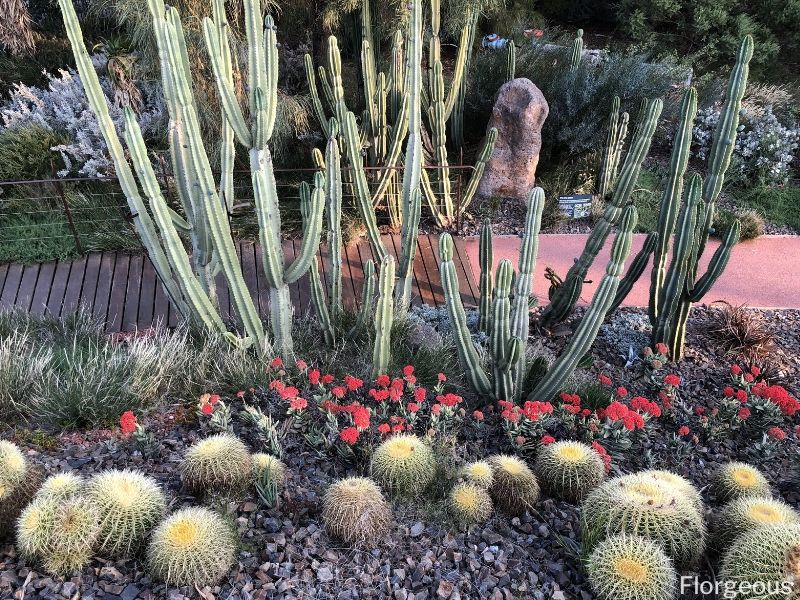
Since succulents come from different families, they vary in growth habits too. Some have the infamous rosette form, others are branching and trailing like Crassula ovata and Senecio rowleyanus. These kinds are great for indoors since they are compact and they adjust well to low light.
Aloe vera, Euphorbia tirucalli, and Echinocactus grusonii have thicker parts that thrive under full sun. These succulents are best grown outdoors (1).
Some succulent species and varieties have colored foliage such as Echeveria, Kalanchoe, and Sedum. Like most ornamental plants, these leaves will retain their color under the full sun. Schlumbergera, Echinopsis, and Gymnocalycium are the kinds that produce flowers for indoor color.
Common Types of Succulents
If you’d like to explore different classifications and families of succulents or if you’re just wondering what kind of succulent you already have in your garden, below is a list of the popular ones. You can find most of these plants from many succulent subscription services.
Agave
1. Agave americana, Century Plant

As the name implies, this succulent originated from the sunny parts of America like Texas and Arizona. Since the plant is drought-tolerant and loves the bright sun, it is often found in desert-themed landscape designs where it provides a strong focal point. The tough pointed leaves also serve as a good barrier.
A. americana is best known for its sturdy rosette of toothed blue-green leaves. In the garden, it can grow up to 2 meters tall and 3 meters wide, just let it set root in sandy or well-draining soil. The plant can survive winter too but make sure to minimize watering to only once a month.
2. Agave albopilosa, White Hair Agave
A smaller plant in the group, A. albopilosa only grows up to a foot tall so it is the perfect agave to grow indoors. The narrow green leaves almost look like stout clumps of grasses with distinct fine white hair-like tufts on each tip. The leaf tip is also pointed so be careful when placing the plant inside the house.
3. Agave stricta ‘Nana’, Dwarf Hedgehog Agave
The needle-like green leaves that form a round shape makes the plant look like a hedgehog, hence the common name. Although this agave grows only a foot big, the leaves are so fine and pointed, they are better left outdoors or on the patio. It grows close to the ground so the form of the plant can be better appreciated when elevated in pots or planters.
Most agaves rarely flower but when they do, it is usually towards the end of their life cycle. This agave produces a long stalk of purple flowers. It also reproduces from underground rhizomes so new plantlets grow at the base making it look like mother hedgehog cuddling its babies.
Aloe
4. Aloe albida, Grass Aloe
Aloes are known for their striking foliage but A. albida is well-received not just for the messy but attractive slender leaves but for the flowers it produces too. Several long stalks sprout in the middle of the rosette and on top forms clusters of white flowers. A mass of this plant in the garden creates a beautiful border and when potted, A. albida makes a great statement plant too.
Aloes love good sun exposure but indirect light is ideal for healthy growth. They also establish well in sandy soils as they do not like to be waterlogged. Too much moisture causes the roots and the base of the plant to rot. For this reason, many people use moisture meters to make sure they don’t over water their plants.
5. Aloe ‘Venus’
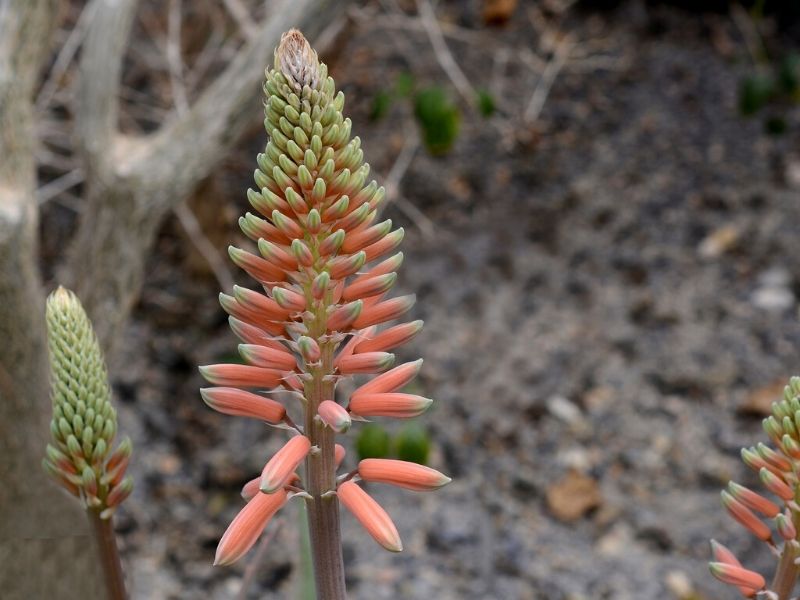
This aloe variety looks simple with its typical pointed and toothed green leaves for most of the year but come fall, it bears a surprising and attractive blossom. Cone-like bright red and white florets on long stalks persist until the early days of winter, bringing a pop of color to the garden.
6. Aloe compressa
This unique formation of leaves on this aloe definitely sets it apart from other garden plants. The horizontally-symmetrical long triangular gray-green leaves sit on top of each other, looking like a multi-pronged trident without the handle. Some varieties have a slight tinge of pink or purple, others have white patterns and stout leaves.
7. Aloe nobilis, Golden Tooth Aloe
A. nobilis draws attention with its rosette leaf formation. These leaves are green with reddish tips and white marginal teeth. They can reach up to a foot high but they can remain smaller and a more striking effect is achieved when they grow in clusters. With its compact size, this succulent is among the most favorite aloes to grow indoors.
8. Aloe ‘Pepe’
This dwarf aloe was derived from a mother plant that resembles haworthia, hence the appearance. The smaller leaves are peppered with white dots and soft teeth. They are arranged in a rosette pattern growing no more than 5 cm big. A. ‘Pepe’ is best planted in a pot spacious enough for it to produce offshoots. Over time the plant will become denser and it can be repotted to a bigger container or the newly established shoots can be transferred in individual pots.
See more: Haworthia cooperi
9. Haworthia retusa, Star Cactus
This unique succulent is among many gardeners’ favorite. The rosette is made of thick leaves that look like they are about to burst. The underside of the leaves is solid green while the upper side appears translucent with green or white striations. Haworthias are generally small, only growing up to 10 cm tall. Other varieties feature dark brown or flattened leaves.
Like the aloe species, haworthias are easy to grow indoors. Sun exposure by the windowsill is enough as well as watering every two to three weeks. They do not like to sit in water so a soil mixture with good drainage is necessary.
10. Bulbine mesembryanthemoides, Window Plant
B. mesembryanthemoides is a succulent that originates from southern Africa. It resembles haworthia but is softer and forms a specialized part called caudex. The stout leaves are translucent at the top looking like jelly beans squished together. It is a small-growing plant, only about 5 cm tall but the floral stalks are 20 cm high. The flower buds are grain-like blooming into small yellow trumpets.
This succulent grows even in poor soil and they can be used in rock gardens and containers. The root and caudex just need full sun, good anchorage and soil that does not hold water for too long.
Aster
11. Senecio rowleyanus, String of Pearls
Also called Curio rowleyanus, this aster succulent is exceptional that it has become one of the top modern indoor succulents. Round pea-like leaves attached to long trailing stems earned the plant its common name.
As one of the most popular hanging succulents, truly striking when planted in hanging containers, this succulent can serve as a curtain-like barrier or they can be a focal point by itself indoors.
In their natural habitat, S. rowleyanus prefers partial shade but indoors, this light will result in leggy growth. Make sure that the plant receives bright light for most of the day to achieve a compact growth. It is drought-tolerant but still likes damp soil. The plant is best propagated from cuttings.
See more: String of Dolphins
12. Senecio jacobsenii, Trailing Jade
S. jacobensii or Kleinia petraea is a creeping succulent. It is known for the thick stems bearing flat rounded green leaves. The stem elongates and produces roots that make the plant an effective groundcover. The plant can be potted and hung allowing it to the trail and when stems have grown too long, they can be cut and planted in the same container for denser growth.
13. Kleinia stapeliiformis, Pickle Plant
This unique aster succulent looks like a long cucumber sprouting from the ground. The green stems have linear patterns of lighter color and grow a foot high. Each stem bears a bright red or orange flower head on the tip. Because of the size of the plant, K. stapeliiformis can establish well in pots for indoor set-up.
Although the plant is relatively small, the stems are slender and may flop over time. They can be trimmed and the cuttings planted. However, the wound, once healed, may sprout new shoots causing an uneven stem growth.
14. Othonna capensis, Ruby Necklace
Like other trailing succulents, O. capensis bring a simple exotic look when hung indoors but what sets it apart is its signature pop of color. The fleshy oblong green leaves line up the sprawling purple stem. Some varieties have purple or reddish leaves too. In spring, small yellow daisy-like flowers bring contrast and make the plant even more attractive.
Othonnas grow best in full sun and can withstand drought. The only special treatment it requires is to have a spacious room for its sprawling habit to prosper. It can be left alone outside but make sure to bring it indoors when winter arrives.
Cactus
There are many types of cactus that you can grow both indoor and outdoor. These next two are some of those good choices.
15. Parodia magnifica, Balloon Cactus
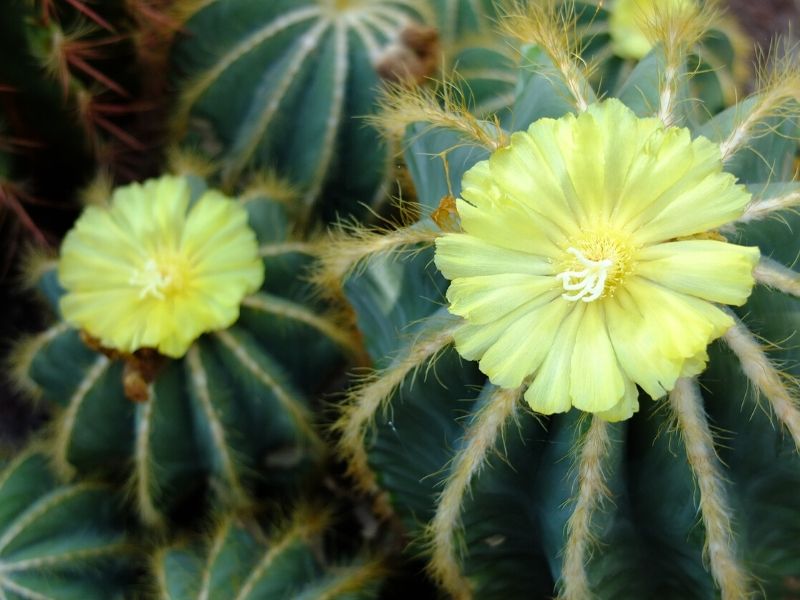
The shape of P. magnifica is common among many cactus. It is normally referred to as balloon cactus because of its globose shape which will turn cylindrical as it matures. The bluish-green stem is lined with 11 to 15 ribs with yellow to golden spines running down each margin. This succulent only grows up to 20 cm tall.
P. magnifica blooms are prized by many growers. The multi-petalled yellow flowers look like stars on top of each stem. Cacti are known to survive extreme drought conditions but this species likes a lightly damp airy soil and it also grows well under partial shade.
16. Ferocactus pilosus, Mexican Lime Cactus

F. pilosus is a popular cactus that is easy to care for. It has a barrel shape that elongates upwards as it matures. The 13 to 20 flat ribs develop striking red spines but the younger ones often potted for indoor use have white spines. Flowers ranging from red to yellow appear clustered on top of the stem.
This cactus can reach more than a meter height in the wild. Offshoots grow from the base of the first and over time, the cluster creates an interesting vertical display in the garden.
17. Echinocactus grusonii, Golden Barrel Cactus
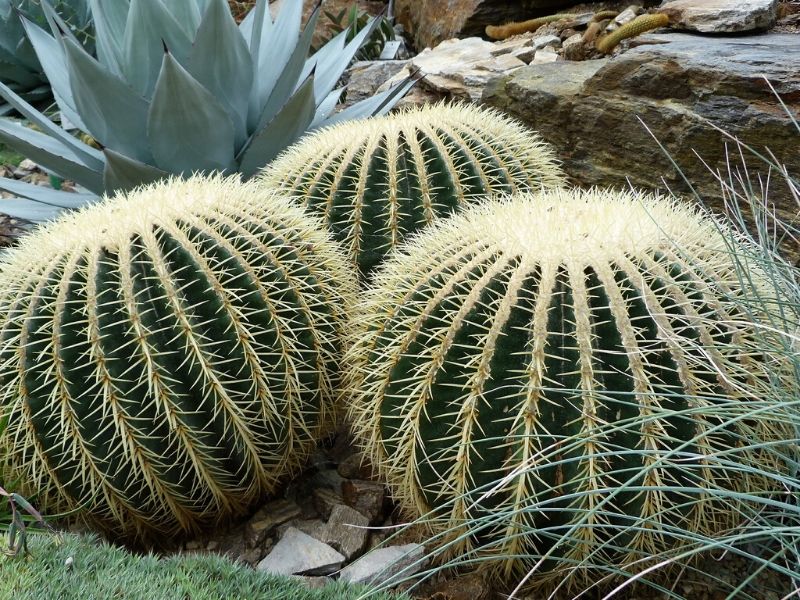
E. grusonii is a round cactus with over 30 ribs with compact yellow spines that look fine and soft from afar. Golden flowers and fruits form on a shallow concave at the top of the stem. The cactus grow solitary and young plants make good tabletop statements when potted. Clusters of mature E. grusonii look like giant sea urchins in the wild.
18. Echinopsis aurea, Golden Easter Lily Cactus
This cactus is short and round and is one of the common cacti cultivated as houseplants. There are 15 ribs on a plant with hard and sharp spines along the curved edges. Most varieties are solitary but there are others that produce basal offshoots. Blooms of this cactus are one to watch out for as they are some of the most striking growing on cacti. The large flowers appear along the ribs with multiple yellow petals and golden centers.
19. Schlumbergera buckleyi, True Christmas Cactus
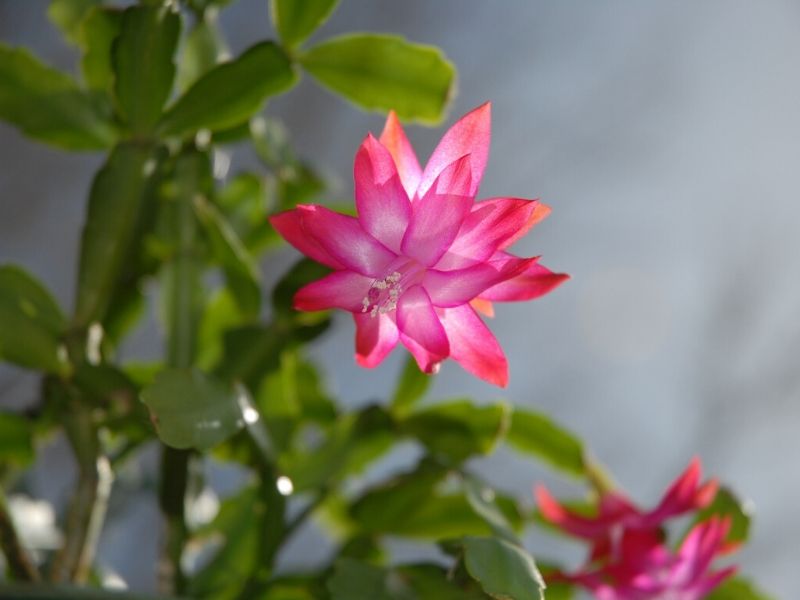
The unique fleshy stems of this cactus are long and segmented, almost looking like elongated arms of crabs. Each green segment is flat and as it grows, the stems droop resulting in a cascading effect when potted. Each of these stems will eventually produce layers of bright pink trumpet-like flowers during winter, hence the common name.
20. Gymnocalycium stellatum
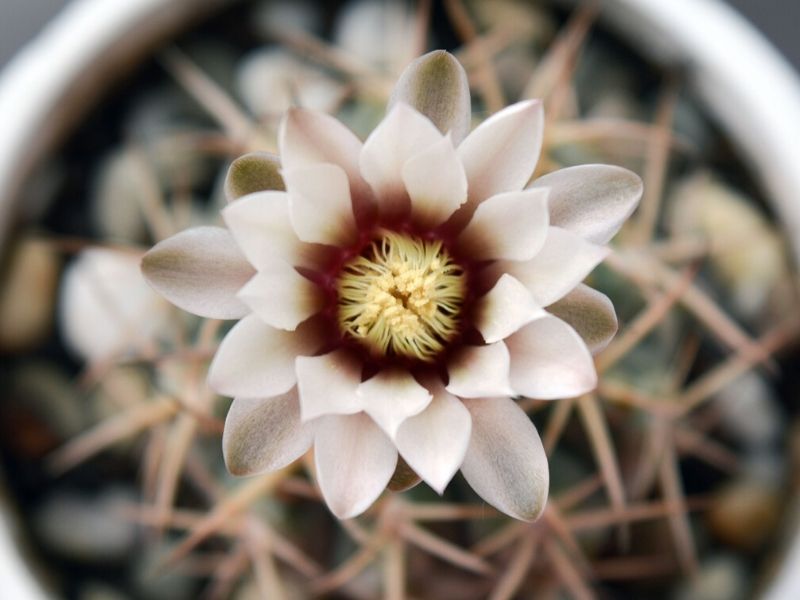
G. stellatum is among the popular cacti referred to by growers as gymno. This species looks like a pumpkin with its thick ribs and flattened globose shape. What’s interesting about the plant is the grayish-brown to muted moss green color of the stem. The spines on the ribs appear fairly safe to touch as they are flattened in growth as well. Some varieties have soft and curved spines. The attractive flowers that form on top are daisy-like with white-reddish ombre petals and a yellow center.
21. Mammillaria plumosa, Feather Cactus
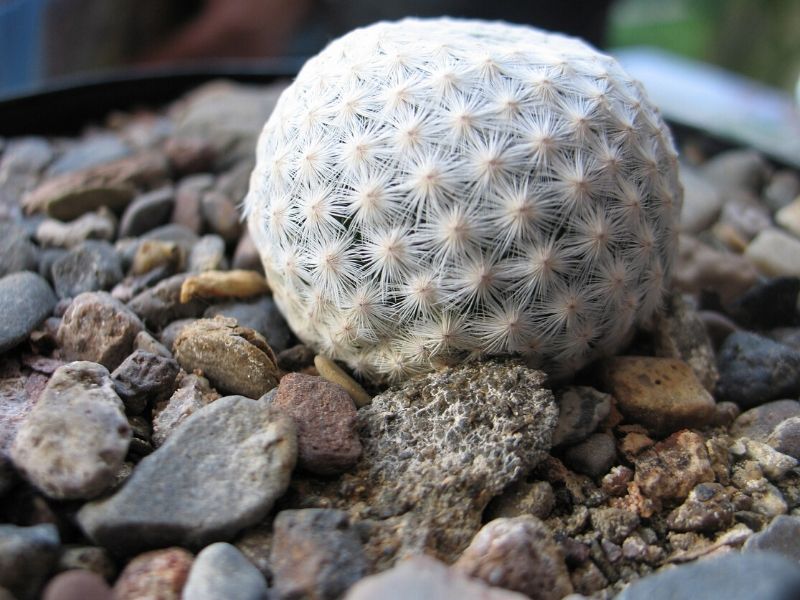
This adorable cactus forms a cluster of round green stems covered in fine white spines making it look like a compact ball of cotton. The soft spines are feather-like in appearance and to the touch which coined the common name, feather cactus. When the plant blooms, several tiny white flowers appear that look like daisies floating on clouds.
22. Mammillaria elongata, Lady Finger Cactus
Another mammillaria species, the M. elongata is the easiest cactus to grow. The green cylindrical stems are usually clustered together giving the plant a finger-like appearance, hence the common name. Each stem is covered in golden spines that curve inward and they can grow up to half a foot long.
Growing M. elongata little to no effort, it can fend for itself for over months. It is extremely drought-tolerant but unlike other cacti that store water in their ribs, mammillaria has specialized parts called tubercles that expand as water storage. Given the right conditions, the plant will outgrow its container in a year so annual repotting is necessary.
23. Epiphyllum hookeri, Hooker’s Orchid Cactus
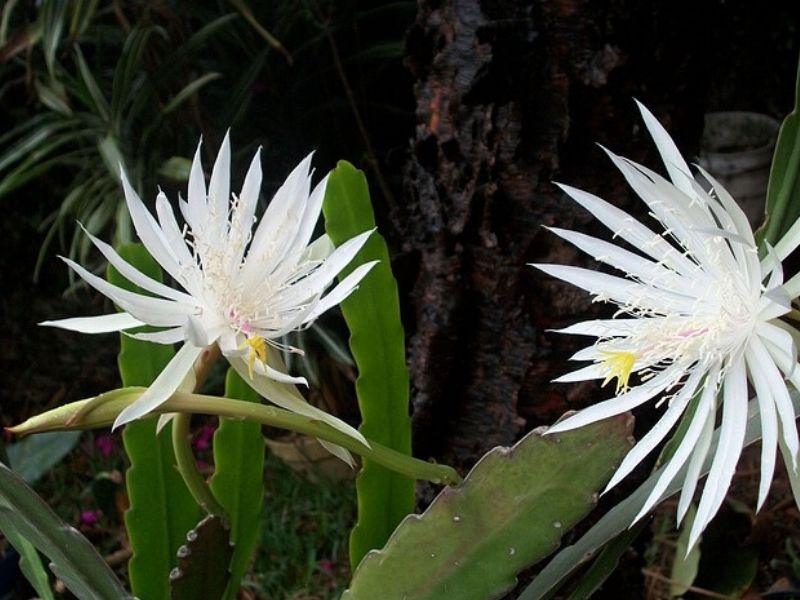
As the name suggests, E. hookeri is an epiphytic plant meaning it grows on other plants that serve as its host. It is also considered a climbing cactus as it produces airy elongated stems that the plant uses to grow on other plants. As an indoor plant, this growth habit can be best displayed in hanging containers. When the plant blooms, showy white-petalled flowers appear all over the plant. They only bloom at night and close as the sun rises.
24. Acanthocereus tetragonus, Fairy Castle Cactus
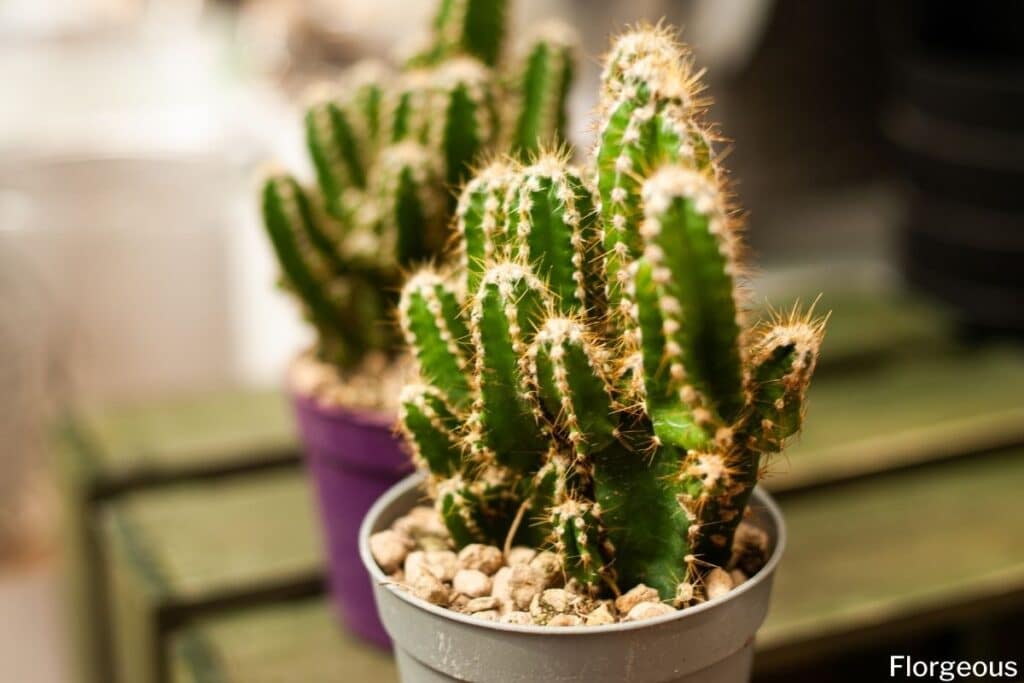
A. tetragonus has a branching growth that is the inspiration for the common name. Stems grow from the base of the plant and as they mature, they develop five ribs lined with dots of tiny white spines. The varying heights of each stem create an architectural appeal resembling towers of a castle. The Fairy Castle Cactus produces large night-blooming white flowers but these are rarely seen in an ornamentally grown species.
25. Stenocactus multicostatus, Brain Cactus
A distinct cactus that certainly serves as a talking piece indoors, S. multicostatus is worth growing. This small round cactus is made of multiple wavy ribs that resemble the wrinkles of a brain. Some also say that it looks like a piped icing on a cake. Hard pointed spines are alternately arranged on each rib in spring, some are lucky to have showy pink or purple flowers growing on top of the plant.
26. Rhipsalis baccifera, Mistletoe Cactus
Another type of epiphytic cacti, R. baccifera has been gaining popularity among collectors and gardeners. The branching slender green stems of the plant reproduces and elongates causing a drooping hair-like effect. The spines are fine and tiny, they won’t be noticeable from afar. The plant also produces tiny white flowers that turn into white eyeball-like fruits along the stems.
Dogbane
27. Adenium arabicum, Desert Rose
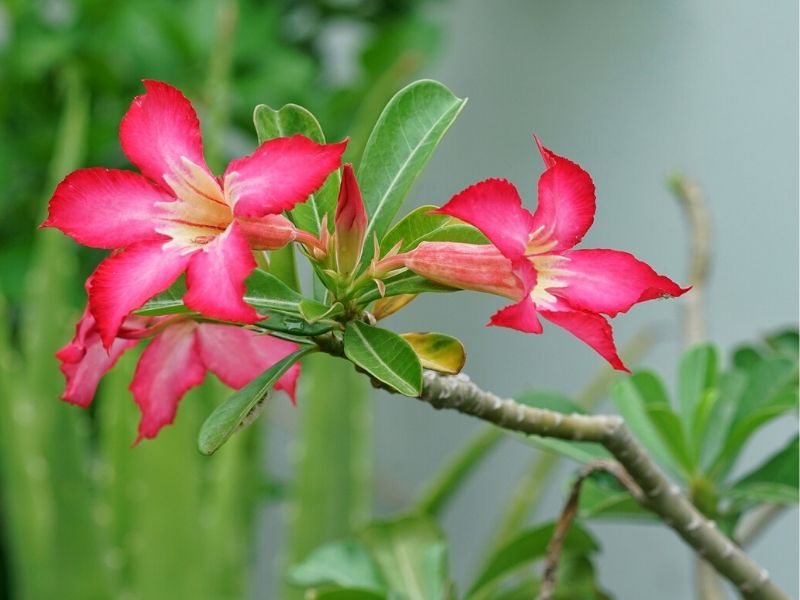
Commonly referred to as desert rose, this succulent is shrub type and is traditionally grown by grandmothers in their gardens. The stout smooth trunk of the plant produces multiple thick grayish-green fleshy branches with a terminal rosette of flat and veined leaves. The signature trumpet flowers are red or pink on the edges and white to golden at the center.
Desert rose is commonly planted in decorative pots to be placed by the patio where it can receive ample sunlight. But it works in the garden too, creating a beautiful focal point. However, it should not be mixed with water-loving plants as this succulent will deteriorate in damp soil.
28. Cyphostemma juttae, Wild Grape
This succulent is commonly called wild grape because it produces clusters of red fruits that resemble grapes. However, they are not edible and may be poisonous when consumed in large amounts. C. juttae grows tall, up to 2 meters high and its stem looks like a trunk with peeling bark and branches. The terminal grayish-green leaves are thick with pointed but soft teeth on the edges.
Because of its large but slow growth habit, this succulent is usually planted in open gardens. But the young plant can be potted too which serves as a striking accent to front doors or even indoors where they receive bright light.
29. Pachypodium bispinosum
P. bispinosum is a one-of-a-kind succulent that creates an instant statement when potted. The mature two feet tall plant owes its height to the large tuberous stem called caudiciform that looks like a giant potato. The stem tapers where stems grow to produce long thick dark green leaves and pink trumpet-like flowers.
Although they can grow on the ground, this succulent is better off potted to conveniently move indoors during winter. It is a drought-tolerant plant that is very sensitive to frost and overwatering. To induce flowering, it is best to place the plant where it will receive bright full sunlight.
30. Pachypodium rosulatum, Elephant’s Foot Plant
This pachypodium is perennial in nature and only grows up to a foot tall. Instead of a smooth stem, the caudiciform has many thick pointed spines up to the apex where large spear-shaped leaves form. Because of its deciduous nature, the leaves fall off in autumn and are sometimes replaced with bright yellow flowers.
31. Stapelianthus decaryi
This exotic-looking succulent is definitely an eye-catcher. Growing only up to 10 cm tall, the rough gray-green stems are waxy and elongates in a curve-like manner. The protruding tubercles on the stem have pointed white spines. In autumn, upward-facing bell-shaped yellow flowers appear. They are covered in tiny white hairs and maroon speckles.
This type of succulent is best grown outdoors where the open environment is airy and fully lit. It does not perform well indoors and in wet soil conditions. The anticipated flowers only bloom when the plant is exposed to full sunlight.
32. Tridentea longipes
Previously called Stapelia longipes, this plant also produces compact clumps of curved stems. However, stems are four-sided and the spikes are less prominent. It grows close to the ground and the flowers are produced on long reddish stalks that grow from its base. The star-shaped flowers have a base color of yellow and maroon striations. Covered in longer white hair-like structures, the flowers look like starfishes on the seafloor.
33. Caralluma indica
Another member of the Stapelia family, C. indica also has rough stems but shorter. It is a rather small plant, about 20 cm tall and fits a medium-sized pot for container-growing. At the end of a short stalk, 5-petalled star-like deep red or purple flowers appear in a round cluster.
Echeveria
34. Echeveria ‘Autumn Flame’
Echeverias are popular succulents grown as houseplants and one of the prized hybrids is the ‘Autumn Flame’. The rosette of leaves is shiny and curved and instead of the usual green color, they come in deep red with a lighter shade towards the margin. This striking medium-sized potted succulent can be easily mistaken as a rose flower.
Although the plant is usually solitary, offshoots can grow from fleshy stalks and can be potted on its own. Echeverias grow best under full sun and dry soil but can tolerate partial shade. However, this causes a lanky growth and a decrease in the intensity of the leaf color.
35. Echeveria ‘Encantada’
This whimsical echeveria is definitely an eye-catcher. The teardrop-shaped leaves are arranged in a rosette form and each fleshy leaf is frosty white in color. It grows close to the ground and in fall, long stalks carry clusters of extended leaves that protect delicate bright orange flowers.
‘Encantada’ looks so enchanting that it is often grown indoors but it should be placed where it can receive sunlight for the most part of the day. Flowering will only proceed there is natural light too as well as well-draining soil.
36. Echeveria tolimanensis
E. tolimanensis is another frosty-looking succulent that grows up to a foot tall. The appearance is that of a lotus flower with a layered rosette of thick pointed bean-shaped leaves. Some varieties are purplish and yellow but mostly are silvery green. Side shoots can develop creating a compact mound on the ground or in pots.
The plant produces flowers on branching stalks. They are tiny red or orange-petalled resembling a bell with a yellow center. This echeveria is perfect indoors.
Euphorbia
37. Euphorbia bisellenbeckii, Octopus Arms
E. bisellenbeckii looks like a small version of the usual tall and branching desert cactus. It has slender slightly segmented light-green stems that tend to droop as it grows. New stems will branch out from older stems creating a wiry appearance and each of these bears a series of small concave leaves.
Like most euphorbias, this species can thrive on its own, it does not need constant care and grows healthy even when abandoned. It likes the morning sun and well-draining soil but when planted indoors, the plant will need more frequent watering than most succulents, light watering once a week.
38. Euphorbia schubei
This euphorbia looks like a hybrid between cactus and echeveria. The thick purplish-green stems have distinct stout tubercles with tiny spines on each end. It has a leaning growth habit extending upwards with new stems forming at the base of the plant. As it matures, rosette of leaves forms at the apex of the stem as well as small yellow flowers in between the spines.
39. Euphorbia tirucalli, Pencil Tree
E. tirucalli is a euphorbia like no other. The appealing structure of the plant is based on the long smooth dark green stems of the plant branching at different heights making the plant look like a tree that has lost all its leaves. The plant can reach up to 5 meters tall but maintains a surprisingly tidy size when potted.
The new shoots are light green and bear leaves that soon drop over time. There are varieties that are light green all throughout and some are yellow and red. When grown in clusters in the garden, the fine stems create a soft element in the landscape from afar.
40. Euphorbia pseudoglobosa, False Globose Spurge
A spineless succulent, this euphorbia forms semi-ribbed segmented stems that appear like gray-green balls growing on top of the other when young. The stems eventually elongate and the whole plant forms a prominent caudex. On top of each stem form several tiny yellow flowers. They are slow-growing but they can form a dense mound that is interesting to look at.
Geophyte
41. Albuca namaquensis, Spiral Grass
A. namaquensis is a beautiful succulent that will definitely add character to a collection. Perennially growing from its underground bulb, this geophyte is known for its clumps of long strand-like silvery green leaves that dramatically curl at the ends. They normally grow in sandy or rocky areas but can be cultivated and potted indoors too.
Most of the time, A. namaquensis in pots droops and starts to produce tall stalks bearing small yellow butterfly-like flowers. These blooms are only observed when the plant is grown in a well-draining soil under full sun. The plant does not tolerate cold conditions so it needs to be brought indoors or in a greenhouse come winter.
See more: Albuca spiralis
42. Scadoxus multiflorus, Blood Lily
This succulent is primarily grown for its showy flower heads. A member of the amaryllis family, the plant grows from a rhizomatous bulb and maintains succulent 30 cm-long green leaves throughout the year. In the middle of these leaves grow giant lollipop-like flower heads made of over a hundred coral red florets.
S. multiflorus thrives in sandy well-aerated soil under partial shade. Exposure to direct sunlight damages the delicate leaves and flowers and in winter, the plant may go dormant but will sprout again next spring. Cleaning dried leaves are necessary to maintain a beautiful and healthy plant.
43. Tylecodon singularis
This unique succulent is native to southern Africa and considered rare among collectors. A stem-less plant growing from a tuberous root, it only produces a maximum of 2 large round leaves per plant. The flat thick leaves have prominent venation, green on the upper side and slightly purple on the underside.
Tiny yellow flowers are born on a slender stalk that shoots up from the root as well. In summer, the leaf dries and fall-off which will make the plant seem like it is dead but it will grow new leaves in autumn. T. singularis grows best in shaded areas and damp but not soggy soils.
44. Pelargonium appendiculatum
P. appendiculatum is known for its silvery-green feather-like leaves that form in clumps atop a very short stem. It does not grow higher than a foot but the delicate five-petalled flowers are borne on taller upright stalks. It can be individually potted or grown en masse in the garden.
Pelargoniums are commonly planted in containers to elevate the rather small growth habit and for easy handling during winter. However, they are rarely used indoors but if so, it should be in a fully-lit room. It is very durable and can withstand up to a week without water. New leaves appear when the plant has experienced enough drought signaling that it needs good watering.
Mesem
45. Mesembryanthemum haeckelianum, Yellow Sun Rose
Also scientifically called Aptenia haeckeliana, this perennial succulent makes a durable groundcover. It has creeping stems that grow close and spreads to the ground as they develop flat waxy green leaves. There are variegated ones with white margins too. The aster-like flowers come in yellow, orange, purple, and red appearing in spring to summer.
Mesems like rich soils with good drainage. They need regular watering but overwatering causes stem and root rot. They are better placed in sunny locations where the soil can dry and air circulation is good.
46. Mesembryanthemum crystallinum, Common Ice Plant
A typical mesem that grows low and close to the ground, M. crystallinum is easily identified because of its mesmerizing leaf formation. The individual leaf is made of a small rosette of gray-green and deep purple leaflets. Both stems and leaves are covered in droplets of sap that looks like ice crystals, hence the common name. In the middle of some leaves appear daisy-like flowers in white, pink, or purple.
47. Muiria hortenseae, Mouse Head Mesem
Not necessarily a mesem but belonging to the same family, Aizoaceae, M. hortenseae is among the rarest and unique-looking succulents gardeners could find. The pair of egg-shaped dwarf leaves are green and covered in tiny soft fur. In summer, the smooth surface of the leaves cracks and small multi-petalled white or purple flowers emerge. The fleshy leaves soon deteriorate and new leaves soon replace them.
Muiria succulents are slow-growing and it takes years for the plant to subdivide and form clumps. They naturally grow in rocky areas of southern Africa where the soil is well-draining and where they are exposed to full sun.
48. Lithops comptonii, Living Stones

Lithops are a dwarf succulent that is gaining popularity because of its unique form and ease of care. L. comptonii is a species that has two kidney-shaped leaves hard as a rock. In their natural habitat, they thrive among rocks and because of the gray color of the leaves, they can easily blend only noticeable when their showy yellow flowers bloom.
It can take years for the plant to develop from seeds but once established, lithops is easy to maintain. It will renew its hard leaves yearly and will require little to no water to prevent the leaves from bursting.
Orchid
49. Eulophia petersii, Desert Orchid
This succulent orchid is so durable it can withstand the extremes of a desert environment. It takes up water and stores in underground pseudobulbs and thick waxy leaves. The plant has been cultivated and grown in pots because it is easy to care for and it bears some of the most exotic-looking flowers. Several airy white to mauve blossoms dangle from the long branching floral stalks.
E. petersii develops an intensive root system since it needs to gather all the moisture it can find so when planting in containers, it is best to choose a deep and wide pot. The plant likes the full sun and outdoor growing is ideal but they need rest in winter, especially for a profuse bloom in spring.
Stonecrop
50. Aeonium arboreum
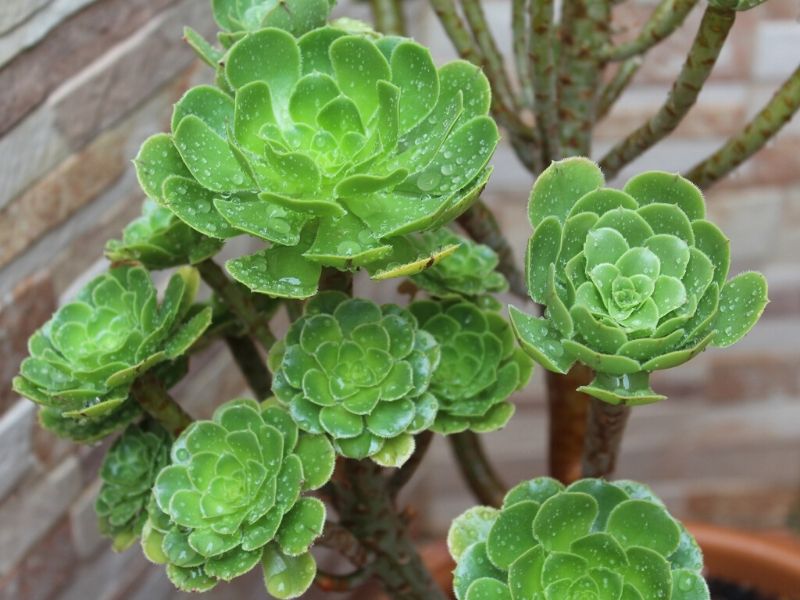
This thick-stemmed succulent is one of the most cultivated stonecrops. The rosette of fine-toothed leaves is borne on the end of each stem which makes it look like a proper rose flower. Under full sun, the variegations in leaf color intensify, there is a mixture of blue and red, deep purple to almost black, and yellow-green.
The real flowers appear in clusters that may grow bigger than the leaves. They look like bouquets of yellow or orange asters ready to be picked. A. arboreum can grow more than a meter tall but the height can be limited when planted in containers. Porous soil and full sun are the best conditions for the plant to prosper.
See more: Types of Rosette Succulents
51. Sedum litoreum, Coastal Stonecrop
This small stonecrop is made of upright fleshy stem covered with bean-like light green leaves. Delicate yellow flowers appear on the plant sporadically. Although it is a very common indoor succulent, the plant is annual and will need replacement after its life cycle.
Almost all sedums are easy to care for and S. litoreum is no exception. It is the best plant for busy people because it survives even when neglected. The plant still has to be placed under bright sun as shade will cause leggy growth.
See more: Golden Sedum
52. Sedum polytrichoides ‘Chocolate Ball’
This sedum is an attractive succulent that forms a dense mat in the garden. This particular variety, as the name suggests, is rich purplish-brown in color making it look impressively artificial. The small needle-like leaves are group together forming a flower-like appearance. The dark contrast reveals the yellow-colored true flowers. This plant is definitely a good addition to rock gardens with other bigger-leafed succulents.
53. Sedum humifusum, Creeping Stonecrop
S. humifusum is the most common succulent grown as semi-groundcover. The rose-like leaves are small and grow close together creating a dense mat. A pot with overflowing sedums makes a good attraction indoors. In summer, several star-shaped yellow flowers appear on top of the leaves.
54. Sedum mocinianum
This beautiful succulent is made of small teardrop-shaped plump leaves that look fluffy due to the white fur-like structure covering them. Clusters of these leaves grow in sandy soils and rock crevices and they can be potted for indoor use too. Towering flower stalks with white blossoms at the tip make a potted plant look like it has a cold ecosystem of its own.
55. Sedum burrito, Burro’s Tail
This sedum burrito is a popular hanging houseplant. The stems are initially upright but as they grow and bear compact bean-like leaves, the stems become heavy and they droop like a tail from the container which is the inspiration for the common name. The blue-green leaves and stems can extend up to half a meter long.
56. Sedeveria ‘Jet Beads’
This succulent hybrid is a result of crossing sedum and echeveria. It has dark, almost black leaves on a short stem that grows no more than 10 cm high. The black color of the leaves intensifies when the weather is cold and the sun is up and fades to green in shaded conditions.
57. Hylotelephium cauticola, Cliff Stonecrop
H. cauticola is the ideal edging for a succulent or desert-themed garden. It is an effective ground cover with flower-like mature gray-green leaves. The new leaves and flower formations are purplish to deep pink, adding a charming effect to the garden. This succulent naturally grows in the cliffs of Japan, hence the common name.
58. Crassula ovata, Jade Plant
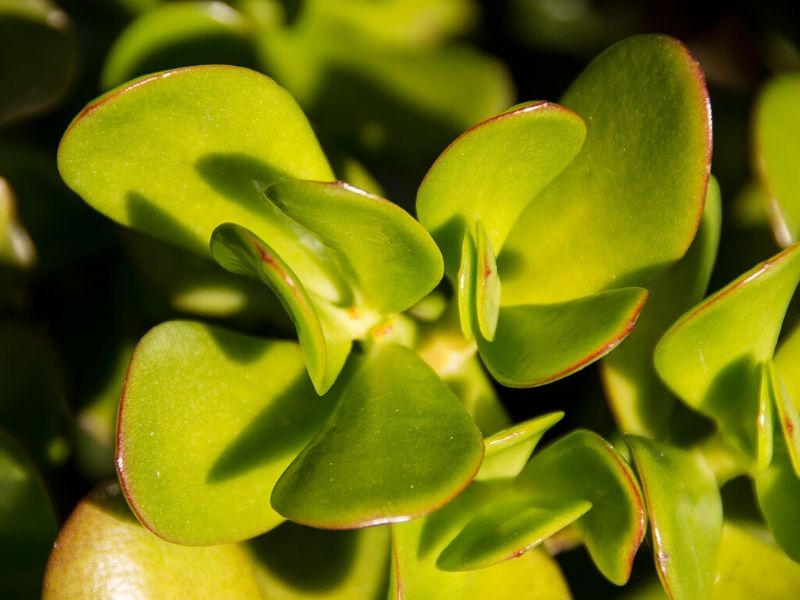
Also called the lucky plant, this succulent is a popular houseplant. The Chinese believed that the Crassula ovata plant attracts money because the leaves look like coins. Although there is no scientific basis to that, this succulent is still an effective indoor plant because of the attractive form and stress-free maintenance.
It is a small plant that fits small containers but tends to grow lanky in the shade. It can also be allowed to grow a tree-like form in the garden.
See more: Crassula Plant Types
Yucca
59. Yucca gigantea, Spineless Yucca
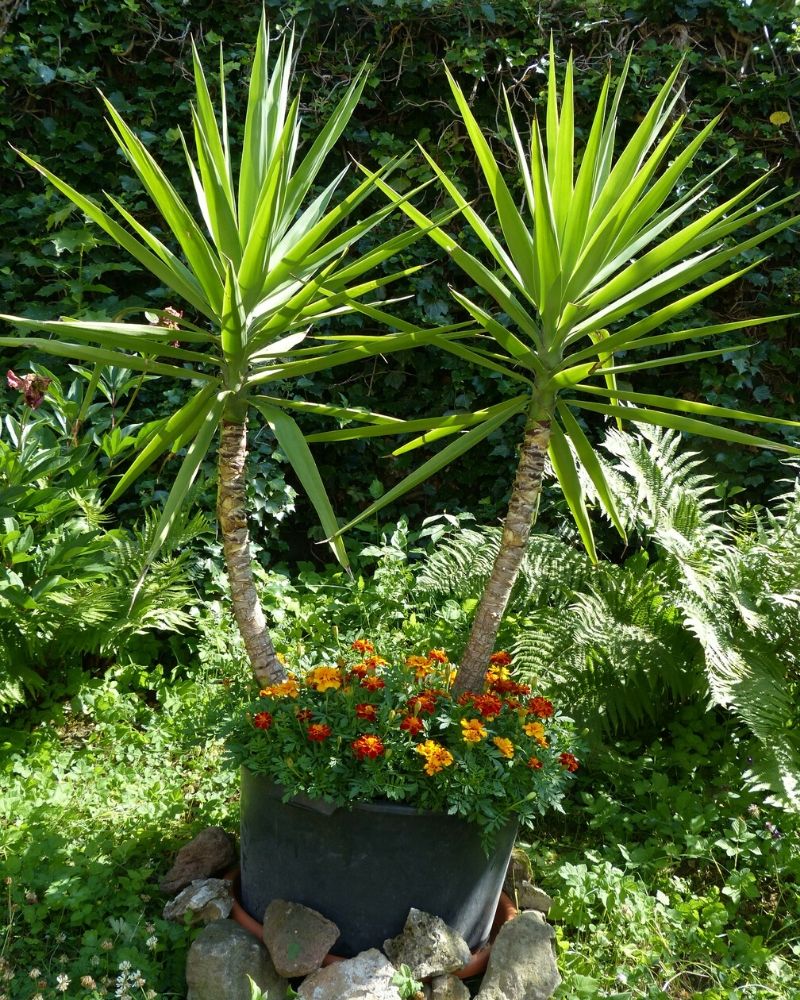
Y. gigantea is a tree-type succulent that reaches up to 10 meters high. Unlike many cute succulents, this plant has a thick spongy trunk usually single and upright but multi-stem production can be induced. A big cluster of strap-like leaves sits atop each stem forming the canopy of the plant.
This plant can be potted in large containers or allowed to grow on the garden ground where there is bright full sun. When it has overgrown the pot, the trunk tends to grow uneven over time.
There are many types of yucca plants. Yucca does not need a lot of attention and overwatering causes the trunk to decay. Watch out for scale insects too as they like to feed on the leaves and the growing shoot.
Caring for Succulents

Although it has been established that succulents can grow without much gardening effort, they will grow better and thrive longer if the right maintenance is applied. This means you need to know how to care for succulents.
A common misconception is that succulents often die if given the attention so growers just leave them be. The problem with this is that one would not know if there is an onset of pest infestation or if the plant is receiving enough light or water to the flower.
Since they are technically living storage of water, succulents do not need to be irrigated as frequently as most plants should be. If you’ve lost track of your watering schedule, it is okay to leave the plant as is for the next 3 to 5 days before applying water. It is also important to make sure that the potting containers have drainage holes to avoid soil saturation leading to root rot and fungal disease (1).
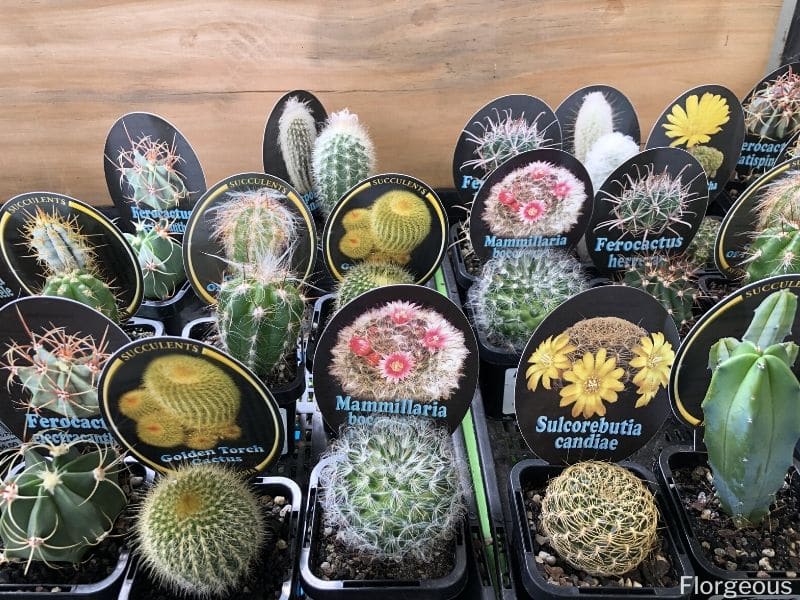
Potted succulents also need to be repotted every year, especially if they have overgrown the container. Repotting succulents helps the plant roots to develop and avoid overcrowding and it also creates better airflow. Fertilizers can be mixed into the new soil to be added to keep the plant healthy.
When it comes to growing media, all succulents need well-draining soil. A mixture of compost, garden soil, and sand or perlite is ideal. This keeps the medium porous while retaining enough nutrients and moisture for plant uptake. As a result, pests will not thrive in the soil and waterlogging is avoided.
The most common pests of succulents are scale insect, mealy bugs, aphids, and fungus. Most succulents are soft and these pests will try to suck out the juices and nutrients from the plants. It is important to stay vigilant and identify the pests before the infestation worsens. There are many commercially available insecticides in local stores like Lannate and Furadan.
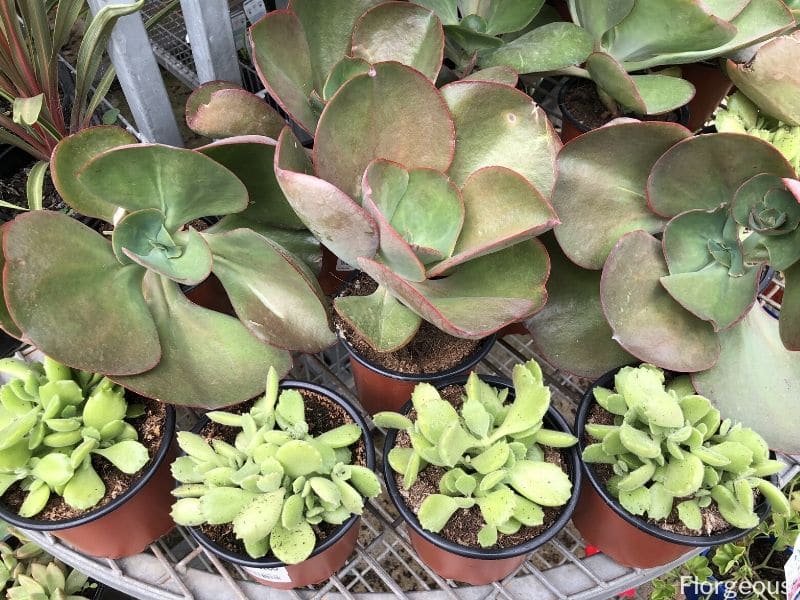
Other options include spraying of isopropyl alcohol, soap solution, or neem oil to infested areas. When using tools to transfer or propagate the plants, make sure to sterilize them to prevent contamination.
Since succulents are known to originate from tropical, arid, and desert regions so there are concerns when they are grown in areas experiencing winter. They will definitely survive the cold but they will need to be protected from frost by bringing them indoors or in greenhouses.
Some of them will lose above-ground parts and become dormant while others will look rather dull. The technique is to fertilize them before summer ends and make sure to avoid watering, especially when temperatures are extremely low (4).
See more: How to propagate succulents
Common FAQs
What’s the difference between a cactus and a succulent?
To identify cacti and succulents, you only need to know that all cacti are succulents but not all succulents are cacti. One characteristic specific to cacti is the presence of specialized parts called areolas. Those areolas are where the signature cactus spines are produced.
How do I propagate succulents?
Most succulents grow fast and tend to outgrow their containers. The growing parts are the source of propagules to produce new plants. Cuttings from elongating stems like that of Mistletoe Cactus and Christmas cactus are allowed to dry and then planted in sandy soil to form new roots.
Offsets from most aloes, cactus, and echeverias can be removed from the mother plant and repotted. Almost all succulents produce seeds as well for planting but this takes a long time and requires more effort.
What are the best plants to grow with succulents?
Since succulents are very particular with their water requirement, it is necessary to grow them with other plants that share the same needs, especially in the garden. You can’t grow cactus and fern in the same container as one will survive as the other won’t.
Succulents are best paired with bromeliads, cycads, and welwitschias. Consider also the overall appeal of the plants in the garden composition, make sure that they are complementing the other in terms of appearance too.
What is xeriscape?
A xeriscape is a landscape design or style that revolves around the concept of minimal irrigation and care. It is a well-thought-of design using only plants that are suited for hot and dry conditions without compromising beauty. Naturally, low water plants just like cacti and succulents are the top choices for xeriscapes.
Do succulents have other properties aside from ornamental use?
The unique and striking architecture and geometry of succulents are what make them effective ornamental plants but they play a role in culinary and medicinal industries too. Aloes and agaves are common sources of antiseptic and wound-healing remedies.
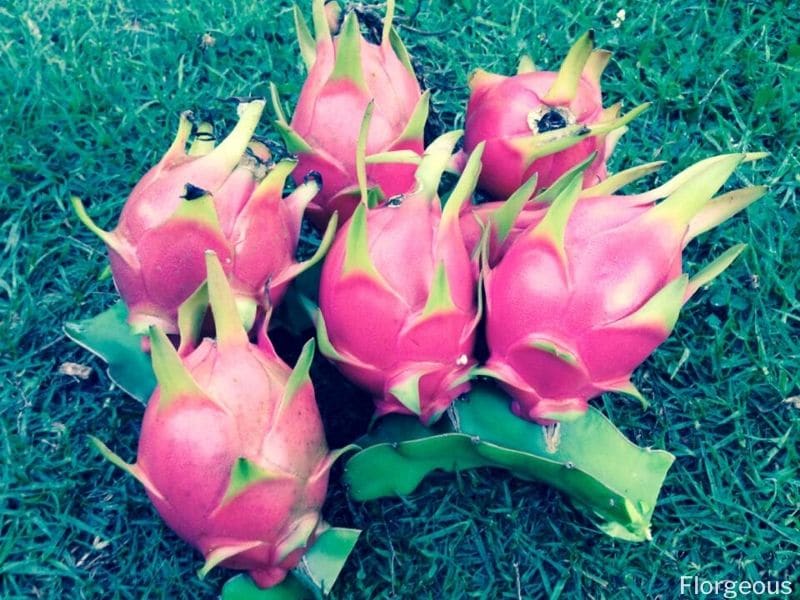
Dragon fruit from a cactus species is an edible fruit and is a good source of fiber and vitamin C. Stonecrops like sedums can also be eaten raw or cooked and is said to relieve coughs and burns as well as lower blood pressure.
Which succulents are poisonous to cats?
Cacti are spiny succulents that pose harm to kids and pets when placed indoors. But this is not the only thing to be concerned about succulents. Some succulents have toxic properties that cause skin irritation or poisoning.
These include most aloes and euphorbias and jade plants. Keep your pets and kids away from these plants at all times or just don’t bring them indoors where they can easily be reached. Succulents that are fairly non-toxic are haworthia, Christmas cactus, senecio and burro’s tail.
See more: Common Succulents That Are Toxic to Pets
How do I get rid of snails on my succulents?
Snails and slugs love the soft tissues of succulents and just overnight exposure can lead to the sudden death of the plants. They can easily be managed by applying granular molluscicide.
A more environmentally friendly way of getting rid of these pests is by crushing eggshells and scattering them around the garden or pots. Snails and slugs get easily irritated with the sharp edges of the shells that this will keep them from attacking your succulents.
See more: how to get rid of mealybugs
Will a cactus stem that broke in two still survive?
Most cacti are hardy and durable. Sometimes, the stems may get damaged from handling and break. Aside from the probably uneven or less attractive looking plant, there is not a lot to worry about because the plant will still grow.
Make a clean cut using a sterilized garden knife along the messy wound and allow it to dry. For the severed stem, make a clean cut as well and once it has dried and formed callus, you can plant it in porous soil where it will eventually develop new roots.
What is the most common type of succulent?
Aloe vera is one of the most common types of succulents. Known for its distinctive rosette of fleshy, serrated leaves, Aloe vera is popular not only for its ornamental value but also for the gel inside its leaves, which is commonly used for various medicinal and skincare purposes. Its hardiness, ease of care, and versatile uses make it a widespread choice among succulent enthusiasts.
What’s the most expensive succulent?
The most expensive succulents are often prized for their rarity and unique features, especially variegated cultivars. Species like Haworthia, Agave, or Echeveria with rare color patterns and distinctive characteristics can command high prices in the succulent collector market. The cost is influenced by factors such as scarcity, aesthetic appeal, and the plant’s overall health and size.
For more varieties of plants and flowers, check out our guide!
References
Reference List:
(1) Tuttle, C. “Succulents.” Penguin. 2015. P. 288.
(2) Bagnasco, J. & Riedmuller, B. “Succulents: Choosing, Growing, and Caring for Cactuses and other Succulents.” Cool Springs Press. 2019. P. 208.
(3) Dimmitt, M. “What is a Succulent, Anyway?” Tucson Cactus and Succulent Society. 2011.F
(4) Chance, L. “Cacti and Succulents for Cold Climates.” Timber Press. 2012. P. 328.
Close







